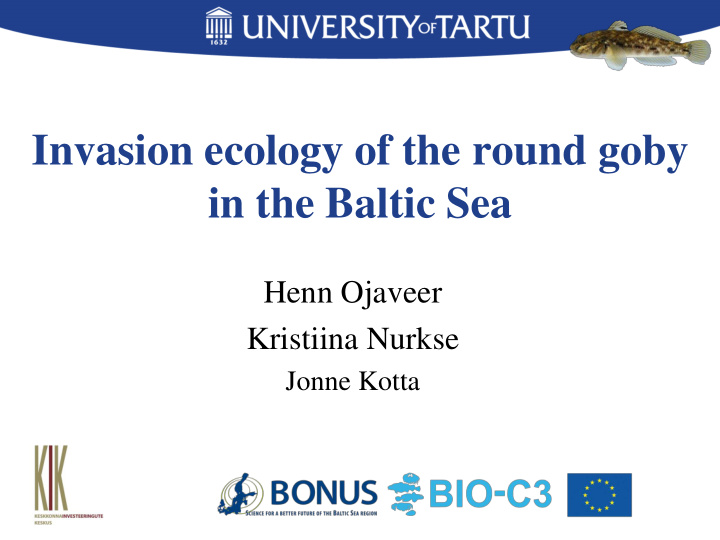



Invasion ecology of the round goby in the Baltic Sea Henn Ojaveer Kristiina Nurkse Jonne Kotta
Distribution Kotta et al. 2016
Driving forces Probability of occurrence explained: 66% by coastline morphology 18% by distance to port Kotta et al. 2016
Density estimation 1. Spring-summer-autumn 2015 and 2016: 18 locations in 3 areas 2. Once in 2016: 33 locations Underwater data collection protocol development: Diving locations
Densities Next step: Modeling densities using different environmental factors Observations: Environmental factors, like exposure, are more important than prey or habitat availability Initial probability of round goby occurrence map Fishermen data is unreliable Nurkse et al. unpubl.
Movement • Acoustic signal receivers set up in a grid in the sea bottom • Record signals from fish (each with timestamp and ID) Small tags (V7) are operated into fish abdominal cavity Fish are positioned in every 10 minute based on signals received by stationary receivers
Movement Currently analyzing: How much do they move? What causes movement (e.g. environmental conditions; suitable habitat availability) How large is their home range? Is it habitat specific? First results: 1. Adults move MUCH MORE than suggested in literature (5m 2 ); 2. Lower prey availability results is larger home range. Nurkse et al. unpubl.
Predation: experimental Laboratory experiments Field experiments (1 m 2 of benthic prey consumed in 10 days) (1 m 2 of bivalves consumed in 30 days) 1m
Predation: results The round goby is a generalist feeder; The round goby has no preference towards prey species; Prey consumption rates substantially higher than the secondary production of benthic invertebrates; Substantial impacts on communities, with 100% mussel removal in 30 days. Nurkse et al. 2016
Stomach content analysis Three areas, spring-summer-autumn, 2015 and 2016 N TOTAL =1728; data under analysis Invertebrate prey consumption % out of total consumed (first draft) Fisrt observations: 1. Consumes important bivalves or amphipods if available; 2. Consumes even barnacles in prey shortage. Nurkse et al. unpubl.
Round goby as prey Three areas, spring-summer-autumn, 2015 and 2016 PERCH First observations: ROUND GOBY 1. Important prey for all dominant piscivorous fish; 2. Main prey for perch; 3. Appears in stomachs of fish in areas where not yet observed by divers; ROUND ROUND 4. Since goby population is GOBY GOBY still expanding in all areas, current densities of piscivorous fish insufficient to control round goby. PIKEPERCH PIKE Nurkse et al. unpubl.
Management
Management • Establishment of a coordinated pan-Baltic monitoring programme and associated data storage and exchange , as well as recording landing statistics ; • Eradication is unrealistic ; • Population control that leads to minimising the risk of transfer to yet uncolonised areas in the Baltic Sea and adjacent water bodies is feasible ; • Landing obligation ; • Management of ships’ ballast water and sediments , and hull fouling of inland and sea-going vessels, and recreational boats. Ojaveer et al. 2015
International cooperation (I)
International cooperation (II)
THANK YOUR FOR YOUR ATTENTION!
Recommend
More recommend